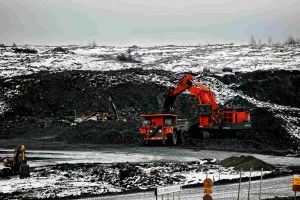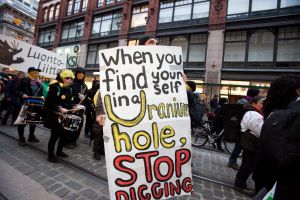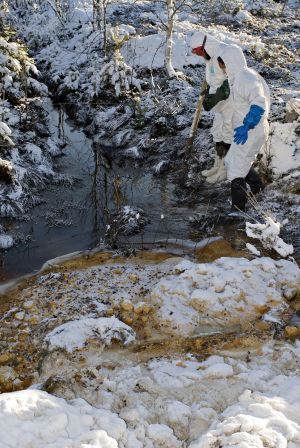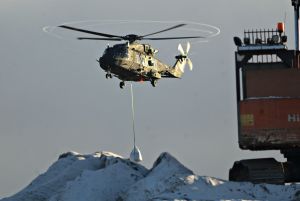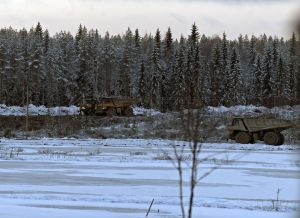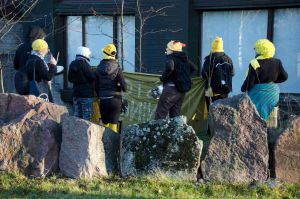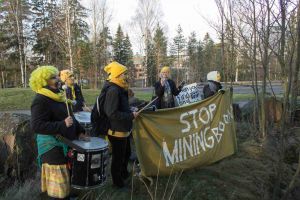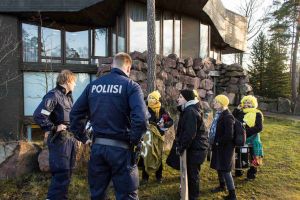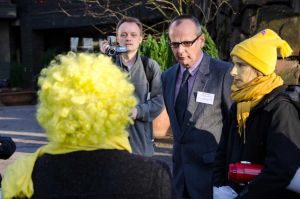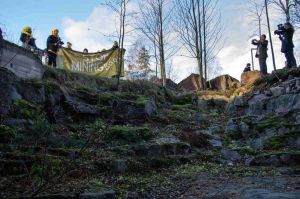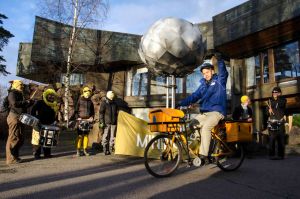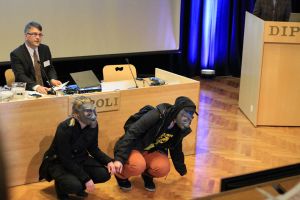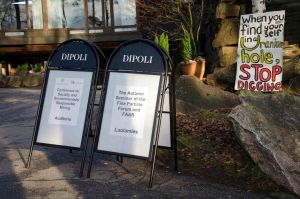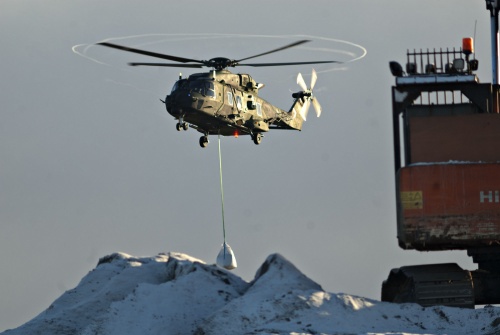Talvivaara mine: environmental disaster in Finland
Talvivaara: Environmental Disaster in Finland
UPDATE 22/11/2012: Talvivaara spill goes on! New leackage found in safety dam!
Since November 4, 2012[1] a cocktail of poisonous chemicals leaked from the Talvivaara mine in Eastern Finland to the surrounding rivers and lakes. An investigation of the Finnish Environment Institute found high levels of aluminium, cadmium, nickel, uranium and zinc in the released waste waters. In a big demonstration led by people from Eastern Finland on November 14, 2012 about 1,000 people demanded to close the mine. A petition with some 18,000 signatures[2] was handed over to the Minister of Environment.[3] The number of signatures is still increasing - as of November 18 about 20,000 people signed the petition[4]. At the same time a small rally took place in Oulu.
Only during the first day of the disaster, over 220,000 cubic metres of waste water have leaked from a gypsum waste pond at the Talvivaara mine in Kainuu. Some of the water has spilled to an area outside the mine.[5] Since that day the leakage continued for at least ten days. The operator of the mine tried for weeks to close the leak[6]. On November 8 they announced to have blocked a leak at its gypsum pond. Only half a day later a new leakage was reported.[6] The same happened again with the "all-clear" message of November 14th, when it was announced again the leakage was eventually blocked - one week later the safety dam was reported to leak again[7]. It is estimated that over 10,000 kilos of nickel and unknown amounts of uranium escaped the mine[6].
According to the Kainuu Employment and Economic Development Centre the gypsum pond was not supposed to be used for storing waste waters, and that there had not been any special permit for that. On November 8, Minister of Environment Ville Niinistö called the leak a "serious environmental crime".[6] Since years local people had accused Talvivaara to have extracted hundreds of tons of uranium a year without permission.[8]
For several days the Talvivaara company was not able to locate the site of the leak[9]. Since the beginning of the catastrophe, the mine has discharged hundreds of thousands of cubic metres of toxic effluent into the nearby environment[10]. According to a local newspaper some 4,000 cubic metres of waste water escaped the Talvivaara mine per hour[11]. Greenpeace called it "Finland's biggest chemical catastrophe in history"[1].
The mine has leaked heavy metals like cadmium and nickel into its surroundings and nearby lakes. The uranium concentration in the effluent has risen by 100-200 times its normal level in the bottom and surface waters.[10] Military and civil helicopters were in operation to plug the leaks in the waste water dam. "Helicopters are used to dump neutralizing calcium into the waste water, as well as moving concrete and patching material to leakages" explained the news company YLE. Some 150-200 people were busy to block the leaks and to build a safety dam, said Talvivaara Head of Communications Olli-Pekka Nissinen.[12] Also soldiers from the Kainuu Brigade and local volunteer fire fighters were involved to the rescue activities[13].
According to the Finnish authorities, "pollutants in nearby waterways are at levels that may cause the death of fish and affect plants and bottom-dwelling organisms". Although the the Finnish Radiation and Nuclear Safety Authority claimed the released uranium would not pose a threat to neither environment nor humans, they at the same time admitted it to be a potential health risk when it makes its way into drinking water.[14]
Chair of the parliament’s Environment Committee Matti Korhonen said on November 14 authorities should prevent the mine from resuming operations[15].
On November 13, 2012, it was reported that STUK had detected uranium levels in water samples at 350 microgrammes per litre, while the recommended limit is 100 microgrammes.[16]
The company's operation at the Talvivaara mine were shut down after the disaster. Though the company appealed to the authorities to receive a permission for re-starting the business, officials stated this would not happen soon. First investigations have to be taken to understand the causes of the catastrophe and to investigate on the violations of law committed by the company.[17] Such an inspection by the Finnish Safety and Chemicals Agency (Tukes) and Kainuu centre for Economic Development,Transport and the Environment (KAIELY) took place on November 19, 2012[18] - a delegation of independent observers was prevented from joining the inspection[19].
November 22, People's Movement for the Lakes and Rivers informed about a new leakage found in the safety dam. According to them, Talvivaara Mining Company Plc started emergency liming with help of two helicopters dropping the lime from 300-500 kg containers. People's Movement for the Lakes and Rivers reported again the Lumijoki river carrying a foul stench and a strong odour of sulphur out in the terrain; the color of the flowing water down below from the dam was described to be alarming as in the beginning of the gypsum pond leak: brownish dark yellow. KAIELY played down the incident speaking about "seeking" which wouldn't be seen as a threat. Eventually the government admitted the new leak. People's Movement for the Lakes and Rivers criticized the government's perspective of a "stabilized situation", as it was obviously since the beginning that the "safety dam" and the "back-up pond" wouldn't provide a "stabilized situation".[20]
At least 100 hectares (approx 250 acres) of marshland, streams, lakes and ponds have been polluted by the discharges of waste waters containing uranium and heavy metals. Through heavy application of lime up to a thousand kilogrammes of liquid uranium has accumulated as sediment in the grounds and vegetation of the area. The uranium and the heavy metals such as nickel are about to enter the Vuoksi water system, where they could contaminate 1,000 million cubic metres of water over the level of environmental danger.[21]
Media releases
- Häiritsivätkö aktivistit Talvivaaran velvoitetarkkailua? (February 1, 2013)
- Talvivaara haastoi lintukuvaajan käräjille (January 28, 2013)
- Operaatio Saukko - röyhkeä suunnitelma (January 23, 2013)
- Piilotteleeko Talvivaara biokasaliuotuksen ongelmia? (January 16, 2013)
- Uudet mittaustulokset varmistavat: Talvivaaran lähijärvet ongelmajätekaatopaikkoja (January 9, 2013)
- Talvivaaran lintukuolemien tutkinta ihmetyttää - Miksi poliisi ei tutki Talvivaaraa rikoksesta epäiltynä? (January 4, 2013)
- Kysymyksiä Talvivaarasta - Luonnonsuojelupiiriltä vireillepano Kainuun ELY-keskukselle (December 14, 2012)
- Kansalaisten kaivosseminaari - Talvivaaraa ei valvo kukaan (December 9, 2012)
- Kuka tutkii uraaniketjun myrkkyvaikutuksia? Vähättelyn kierre: vaikutuksia ravintoketjuhin ei ole huomioitu ennen lupia (December 5, 2012)
- Talvivaaran sakka kokonaan säteilyjätettä? Saastuneen suoalueen uraanipitoisuudet todistettavasti koholla (December 5, 2012)
- Kansalaisten kaivosseminaari - MITÄ TAPAHTUU TALVIVAARASSA? (December 4, 2012)
- Perä reveals the origin of water problems at Talvivaara Mine (November 29, 2012)
- Perä paljasti Talvivaaran vesiongelmien alkusyyn (November 29, 2012)
- Thousand kilogrammes of uranium in soluble form on the terrain - A massive risk to health and the environment (November 29, 2012)
- Kuka enää uskoo Talvivaaraselityksiä? Jyrkkä EI lähialueen ihmisiltä (November 28, 2012)
- Talvivaaran selitykset ontuvat (November 27, 2012)
- Tuhat kiloa liukoista uraania maastoon - Suuri ympäristö- ja terveysriski toteutui (November 27, 2012)
- Kansalaisten luontoretki tuhotulle Ylä-Lumijärvelle keskiviikkona 28.11.2012 (November 26, 2012)
- Kalakuolemia Talvivaaran pohjoispuolella. Vesien pH:ta on pohjoisen lähivesissä nostettu myrkylliselle tasolle (November 23, 2012)
- SAFETY DAM IS LEAKING - EMERGENCY LIMING HAS BEEN STARTED (November 23, 2012)
- PATO VUOTAA - HÄTÄKALKITUKSET OVAT ALKANEET (November 22, 2012)
- Talvivaara and Finnish Safety and Chemicals Agency (Tukes) do not wish the public to participate in the inspection at the mine (November 21, 2012)
- Is it possible to restart the Talvivaara metal plant? (November 18, 2012)
Background information
At the eastern Finnish Talvivaara Europes largest nickel open cast mine is situated. Since 2008 the mining is in operation 24 hours a day and moved more than 30 millions of tons of soil. In an area as big as 60 square kilometers mining, crushing, chemical treatment and extraction takes place. Besides nickel also big amounts of uranium, copper and cobalt are produced.
In February 2011 he Canadian uranium mining company Cameco made a contract with the Talvivaara operator to construct an uranium extraction facility with a capacity of 350 tons uranium per year. The last years, particularly in summer 2012 a movement against the uranium mine was established in Finland. However, the catastrophe in Talvivaara gathered an unexpected number of people to demonstrate to stop the operation and extension of the mine.
Material:
- photos of the rally in Helsinki (free to use, source must be mentioned)
- petition (scroll down for petition in english)
Further information:
- ↑ 1.0 1.1 http://www.greenpeace.org/international/en/news/Blogs/makingwaves/chemical-spill-finland/blog/42935/ as at November 17, 2012
- ↑ figure corrected from 17,000 to 18,000 after a direct information from Helsinki on November 17, 2012
- ↑ http://yle.fi/uutiset/stop_talvivaara_protest_brings_carnival_mood_to_helsinki/6376956 as at November 17, 2012
- ↑ source: personal information by email from Helsinki on November 18, 2012
- ↑ http://yle.fi/uutiset/talvivaara_waste_water_leaks_into_environment/6363459 as at November 17, 2012
- ↑ 6.0 6.1 6.2 6.3 http://yle.fi/uutiset/talvivaara_waste_water_leak_plugged/6369461 as at November 17, 2012
- ↑ Stop Talvivaara media release as at November 23, 2012
- ↑ http://www.stoptalvivaara.org/fi/newsstream.html as at November 17, 2012
- ↑ http://yle.fi/uutiset/talvivaara_struggles_to_find_leak/6366349 as at November 17, 2012
- ↑ 10.0 10.1 http://www.sll.fi/ajankohtaista/tiedotteet/2012/concern-over-toxic-leak-from-europe2019s-largest-nickel-mine-in-north-eastern-finland as at November 17, 2012
- ↑ http://www.stoptalvivaara.org/fi/waste-towards-savolax.html as at November 17, 2012
- ↑ http://yle.fi/uutiset/talvivaara_waste_water_pond_still_leaking/6371489 as at November 17, 2012
- ↑ http://yle.fi/uutiset/talvivaara_leak_continues/6371975 as at November 17, 2012
- ↑ http://yle.fi/uutiset/mine_leak_environmental_impact_worsens/6373577 as at November 17, 2012
- ↑ http://yle.fi/uutiset/environment_committee_chair_calls_for_halt_to_talvivaara_operations/6375739 as at November 17, 2012
- ↑ http://yle.fi/uutiset/more_heavy_metals_found_in_waters_around_talvivaara/6375294 as at November 12, 2012
- ↑ http://yle.fi/uutiset/probes_into_talvivaara_begin/6379370 as at November 12, 2012
- ↑ see Stop Talvivaara media release as at November 18, 2012
- ↑ see Stop Talvivaara media release as at November 21, 2012
- ↑ see Stop Talvivaara media release as at November 23, 2012
- ↑ http://www.stoptalvivaara.org/fi/release27112012.html as at November 28, 2012
- Action at mining seminar in Helsinki
